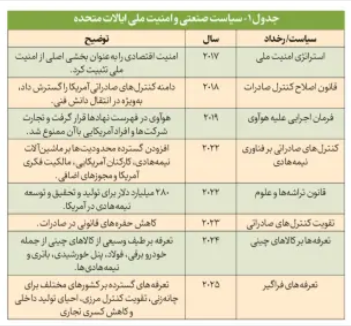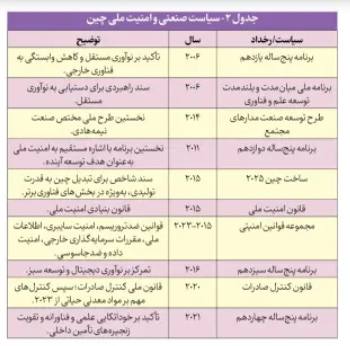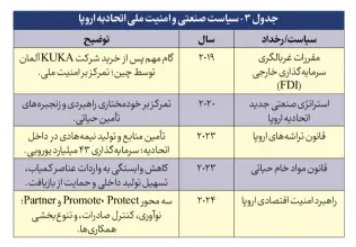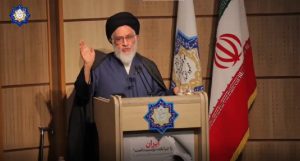Thought Group: Development is the key to the power of countries. But development is not possible without regard to development developments in the northern worlds and the southern worlds. The following article by Ja’frash Barzin On the page Development of Iran Newspaper Written, it deals with this. In the introduction to his article, he emphasizes: “While the south of the world is struggling in the stance of pressure and opportunities; Industrial policy in the northern world has found the role of a national security strategy. The overlap and bold overlap of “industrial policy” with the “National Security Strategy” in the three major poles of the global economy – the United States, China and the European Union – is no longer a temporary reaction to the recent shocks, but reflects a paradigm moving to new economic nationalism. In This article, which is a bitterness of a very detailed article published in Economics It is, while reviewing the intellectual roots of neo -realism and trilogy, the question of how the common goals of technological leadership, the resilience of the supply chain, and the flourishing of domestic production are pursued with different tools and intensities, while at the same time global consequences.
****
Article, It considers industrial policy – in the simplest definition – Strategic Strategic Development of the domestic economy, which is usually aimed at promoting innovative and valuable activities and international competitiveness.;; From this point of view, industrial policy is inherently involving a component of national security because it is tied to economic sovereignty and independence. This companionship has become more pronounced with the return of neo -Turkalist ideas: an idea that calls governments to pursue increased wealth and independence through commercial surplus and support tools. The authors link the intellectual roots of this process to the “American school” (Hamilton, list, etc.) as well as the traditions of East Asia (Fukuzawa), Africa (Nekrome) and the theory of dependence in Latin America.
After decades of conquest of neoliberalism and the decline of industrial policy, since decades, factors such as financial crisis, regional heterogeneity and industrial unemployment in high -income countries, green emergency makers, revealing the vulnerability of supply chains in Kuwavid, and geopolitical stresses. In the meantime, the last two factors – the disruption of the chains and the technological competition – have a more decisive role and are directly tied to the logic of national security.
USA: offensive security with “long fence around the small yard”
The clear turn of the US starts with the National Security Strategy, which was “economic security”; Then, the expansion of CFIUS competences (monitoring of input investments and even some outputs) and the executive order on the ban on trading with Chinese telecommunications infrastructure (such as Huawei) should be considered as signs of economic security. The Biden Government continued this route with the “small courtyard, a long fence” in export controls – focusing on small but vital technologies (especially semiconductors) and intensifying overseas by abolishing the Customs Act called “de Minimis” and the rules of the American. Key to the large -scale chip production subsidies on American soil. In the 5th, extensive tariffs on Chinese imports (steel, aluminum, solar panel, battery, electric car, etc.) were exacerbated by the supply chain security reasoning.

The infrastructure logic is triangle:
• The competitor of China’s alignment in production and technology has exacerbated chain dependencies and threats of American industries.
• Security perception of China’s military development and conflicts around Taiwan;
• US domestic politics – The new alliance of industry workers has been with anti -unionist populism and the demand for re -industrialization.
Alongside these, artificial intelligence is interpreted as a massive economic opportunity and a military coefficient, and as a result, it has been transferred to the “high fence”. In both parties, return to Security -oriented neo -trivialism This image can be formulated by a set of instances – from CFIUS and the list of entities to Chips and the new wave of tariffs; But their nuclear meaning is all reduced to relying on China, the revival of vital capacities, and the exercise of overseas power in controlling dual technologies.
China: Continuing development planning with “endogenous security policy” policy
China has always had active industrial policy in the long -term horizon; But from the five -year programs 1 to 2, the idea of independent innovation and then national security as “strategic logic” entered the text of the planning. China’s initiative targeted ten key industries (from biotechnology and aerospace to robotics and the next generation IT) and expanded security and data laws (national security, cyber security, national intelligence, etc.) expanded the scope of industrial policy in covering “security protection” from foreign investment restrictions on key technologies.
From 5 onwards, the concept of “comprehensive national security” has been strengthened in the discourse of Shi Jinping; Dual circulation was proposed as a doctrine of the domestic market strengthening with the diversity of foreign markets to reduce the vulnerability of the chains.;; Anti -espionage law (1), export constraints on rare elements/rare areas (vital chip -stricken entrances), and even intervention in the initial external supply of some technology companies should be considered signs of security priority over mere growth.

China’s entrepreneurship is the advantage of cheap work and downstream outsourcing to the technology boundary (in part of MIC 2) as a result of the integration of continuous industrial policy with global environment developments:
From the growing cost of the growing labor force and the need to climb the value chain to the US/Europe resistance against China’s technological climbing and security interpretation of it;; In this regard, the cost of growing labor and the need to climb the value chain cannot be ignored.
Leadership Orientation: The difference between the tone and horizon between Ho Jinteo (renovation and integration into the global economy) and Shi Jinping (revival of national greatness) That has led to the prevailing of security/sovereignty over ‘growth’ That has been a completely decisive issue for China.
China is likely to pursue a strategy of reducing the West and expanding the influence of the trade/chain at the same time.;; Something that will add to the rehabilitation of global supply networks and increase gesture fluctuations.
EU: Strategic autonomy with the balance of “protection/openness”
In the European Union, the link between industrial policy and national security was approved by the adoption of FDI monitoring regulations (after Coca -German purchases); The Kuwavid-2 epidemic then revealed the chain weaknesses, and the European Commission introduced three columns in three: Resilience of a single market, open strategic autonomy, and acceleration in the twin transition (green/digital).
The European Chips Code with three pillars – the “chip for Europe”, the public/private investment framework, and the semiconductor – sought to reduce the dependence and reproduction of part of the chip production through € 5 billion. In addition, the vital raw materials law emphasized the diversity, recycling and facilitating domestic production of rare elements for industrial security.

In 2, the European Economic Security Strategy was approved with three axes of promotion/protection/cooperation (/Protect/Partner); The promotional axis emphasized Europe’s innovative competitiveness, while equilibrium of trade and multilateralism. The conservation axis also proposed the integration of export controls and the expansion of output investment monitoring; In practice, anti -anti -Chinese investigations on Chinese electric cars and the invasion of the Nectic office under the anti -law were signs of the union’s new tools.
The European path is different from America: In official speech, Brussels does not point to a single competitor and strives to balance the protection of strategic technologies and the preservation of commercial ties and multilateral institutions. At the same time, the union’s structural realities – the national status of security and the necessity of consensus among members – limit the supernatural tools. At the same time, there are three stimulus forces:
China’s growing competition at the border of green and digital technologies;Public industrial policy can create innovation and growth within the borders, but internationally is inherently competitive; The market share of a country often reduces the share of others. In practice, the return of industrial policy in the US and Europe has been to some extent reacted to China’s industrial success. Thus, in a world where “competition” is the organizing economic relations, the industrial victory of one actor necessarily has a breakthrough for another.
Capacity focus on three poles: Paper data shows US/China/Europe’s share of world industrial production from 2 % to 2 % to 2 % in 2 % And possibly becomes more; China continues to industrialize, and America/Europe is trying to reversal industrialization. The natural consequence of this focus is more control over advanced technologies and global chain bottlenecks. In addition, the financial and capacity of industrial policy implementation is mainly focused on these three poles.– Positive communication of the government’s financial capacity with the abundance of approved industrial interventions and low -income countries are not capable of adapting massive packages (such as Chips or MIC 2).
Southern South Position
The authors warn that it is not easy to imagine that premature de -industrialization or southern industrial weakness is a direct product of three poles competition – these were a priori problems. At the same time, new geopolitics and the search for chain resilience have created opportunities for a number of “connecting countries/swinging”; Countries such as Morocco, Vietnam, Indonesia, Malaysia and Mexico have benefited from nearshoring and the diversity of origin. Mexico’s example is: US investment (and even China to bypass US tariffs) has been growing since the late 1980s; In Southeast Asia, the attraction of manufacturing investments from both poles has intensified and Vietnam has experienced a major leap in industrial per capita exports.
South -South Industrial Diplomacy with China. The article reminds that China’s partnership pattern in the south of the world is considered less imperialist than the north -south traditions: the focus on infrastructure investment in the host, more respect for sovereignty, and avoiding military presence/explicit political intervention. Global polls also show a more positive understanding of China in many southern countries. Of course, China’s strategy is not homogeneous: it imposes restrictions on some potential rivals (for example, India), while interactive industrial diplomacy with countries such as Brazil/Indonesia/Vietnam. In Africa, there is also evidence of the positive (albeit limited) effect of Chinese firms on infrastructure, technology overflow and economic transformation.
Conclusion
The convergence of industrial policy and national security is not merely a return to the past; Rather, it is a new paradigm that is based on the technological competition of the three supernatural and redefining economic security. The result of this trend is the weakening of the economy/security boundary and the intensification of zero -gaming games; But at the same time, there are new opportunities for a set of southern countries that intelligently bridge the bridge between the poles. The future path depends on how governments balance between competition and cooperation, security and openness, and national interests and global prosperity.
1
منبع: www.khabaronline.ir




